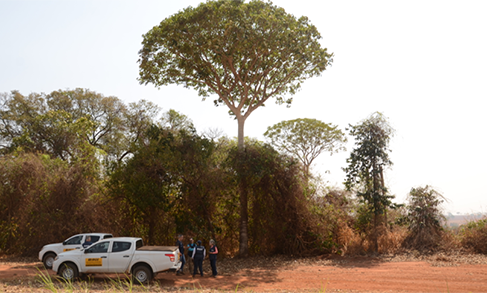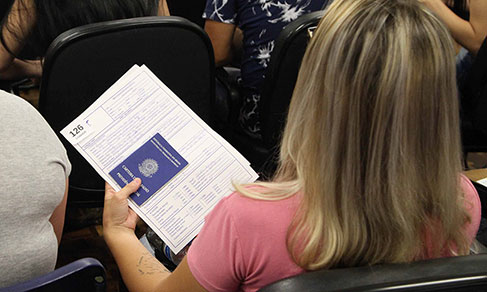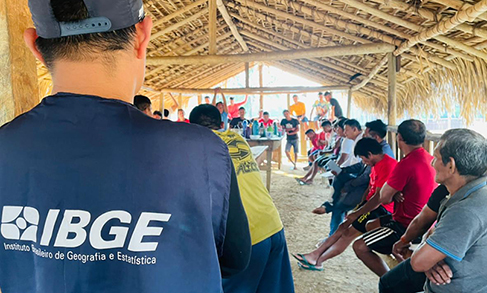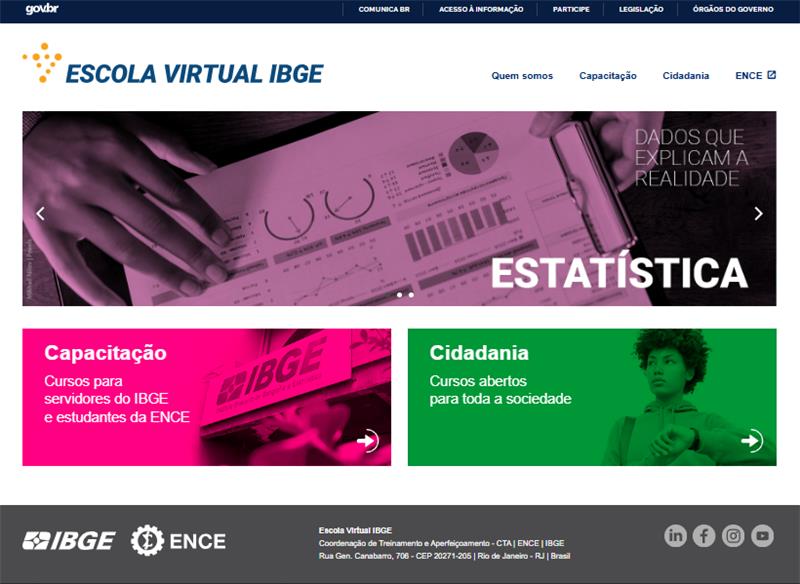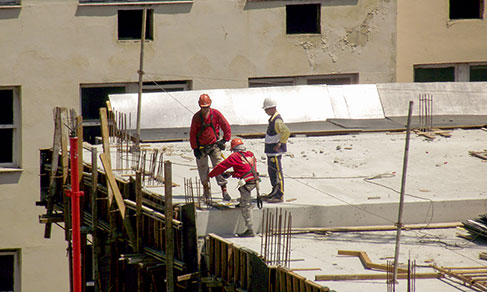International experience
IV National Meeting of Enumerators brought President of INE Portugal
September 27, 2021 10h50 AM | Last Updated: September 28, 2021 03h41 PM
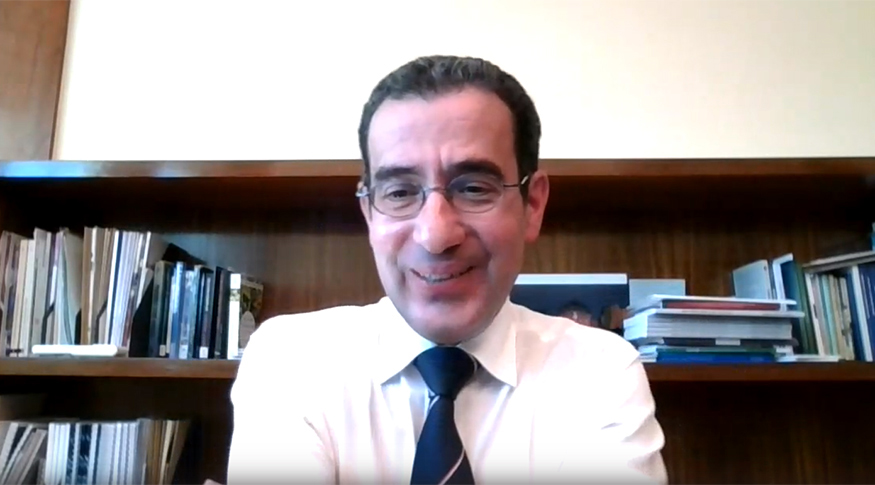
The IBGE carried out last Thursday (23) the IV Meeting of Enumerators with the participation of Francisco Lima, President of the National Statistical Office of Portugal (INE Portugal), who spoke about their Census this year through video conference. Eduardo Rios Neto, President of the IBGE, also participated online and highlighted a characteristic of the IBGE of always following up international experiences.
Francisco Lima was invited by Cimar Azeredo, IBGE´s Director of Surveys. The National Meeting of Enumerators is part of the set up of the Brazilian Census, scheduled for June 2022. Lima enjoyed the initiative and enthusiastically approved the tests that are being carried out in Paquetá Island (RJ), as well as those scheduled in other 27 localities, in 26 states and in the Federal District. He said he is convinced that the idea of “testing, testing and testing” is key in this type of operation.
The president of INE Portugal provided the audience with a comprehensive, deep and focused presentation about the challenges to collect data during the pandemic and how they obtained 99.3% of the questionnaires filled through the Internet. “In the last Census in 2011, we had already obtained a fair rate of answers through the Internet, nearly 50%. This year, our best estimate was a rate of 80%. But we surpassed that, with nearly 100% of the answers through the Internet,” celebrated Francisco Lima, stressing that the operation was only possible due to the progress of the vaccination and the reduction in the hospitalizations due to Covid-19.
The Portuguese Census was already scheduled for 2021 and it cost 40 million euros. The data collection phase occurred between April 5 and May 31 and it was backed by the population, which allowed to complete most of the work in six weeks. Nearly 15 thousand professionals were involved in the operation, being 11 thousand enumerators, who were temporarily hired and trained face-to-face and online, following strict health protocols.
A number of access devices
In the first phase of the data collection between April 5 and 19, the enumerators distributed 6.2 million letters to answer the Census through the Internet. To fill it, residents needed to access the Census website, enter a code and a password available in the letter and answer to the questions of the online questionnaire. The Internet page was designed to adapt to any device, either computers, tablets or cell phones.
The traditional interview carried out by the enumerators was also provided, in which they used their own cell phones with an application developed by INE Portugal to collect the information.
Those Portuguese with difficulties to access the Internet could access the ‘eCounters’, which were available in locations granted by the regional administrations, to fill the questionnaire online supported by trained persons. It was also possible to answer the Census through telephone and, as a last resort, in paper questionnaires.
According to Francisco Lima, 90% of the Portuguese population (9.4 million persons) answered the questionnaires through the Internet into two weeks. Those who did not answer up to May 3 were contacted by the enumerators, who provided another chance through the Internet or through paper questionnaires. As a result of the huge adherence, the data collection of the Census was completed before the scheduled date.
Of the 99.3% digital answers, the medium most used by the Portuguese was the Internet (87.5%), followed by interviews carried out by enumerators (7.7%) and questionnaires filled in ‘eCounters’ (4.1%). The remaining persons filled the questionnaires through telephone (0.4%) and paper questionnaires (0.3%).
Mobilization and partnership with the society
Less than four months after the end of the data collection, in July, INE Portugal released the preliminary results of the Census, which showed that the Portuguese population shrank 2.0% in ten years, adding up to 10.3 million people in 2021. INE Portugal provided an online platform to access the first results. According to Francisco Lima, the complete results will be released up to the fourth quarter of 2022.
In addition to the planning and previous tests, Francisco Lima attributed the success of the operation to the communication plan, which encouraged the population to answer the Census through the Internet, clarifying the importance of the operation, the health security protocols and the confidentiality of the data. To do this, INE Portugal involved a number of sectors of the society, like the government, enterprises, non-profit associations, schools and communication vehicles.
Francisco Lima stated that the significant response through the Internet decisively contributed to the quality, tranquility and safety of the operation. However, he recognizes that the widespread access to the Internet, as well as the social and territorial characteristics of the country, were key to the online answers of nearly the entire population.
“It is obvious that we cannot compare to Brazil, a continental country with different territorial and socioeconomic characteristics from ours. Nevertheless, the success of the operation is the result of the high level of adherence by the citizens, which, in turn, resulted from the huge effort of all who supported, released and participated in the Census,” stated the president of INE Portugal. According to him, the adherence, effort and dissemination did not come from resources destined to advertisement. “For that, we had only 5% of the entire budget. The strong mobilization of INE Portugal with strategic partners and the society in general made the difference.”
For the future of the Census, the Portuguese statistical office is already developing a national data structure integrated with administrative records. INE Portugal aims at extensively using the data, applying new techniques to extract information, reducing costs and improving the frequency of the information for the benefit of the society.
IBGE aware of international experiences
Eduardo Rios Neto, President of the IBGE, also participated with the president of INE Portugal and highlighted that the IBGE is always aware of international experiences. In Brazil, the Population Census, scheduled for June 2022, is in the test phase of approaching and equipment in Paquetá Island, in Rio de Janeiro.
“The data collection through the Internet is the future. We are using a hybrid model, collecting data face-to-face, through telephone and through the Internet, due to the Brazilian adversities. We hope that the answering rate through the Internet grows in 2022. I believe it is a trend around the world,” stated Rios Neto.
The design of the Brazilian Census was improved and is based on a mixed and simultaneous model of collecting data in three ways: the traditional face-to-face interview, the interview through telephone and self-filling through the Internet. Another pillar is the health and safety of enumerators and IBGE servants, and of the enumerated population, with health protocols that take into account the best national and international practices.
In addition, the operation will count with up-to-date mechanisms to follow up the best coverage and quality of the census operation: demographic indicators, daily monitored during the enumeration area and the GradePop project, destined to estimate the household density in the enumeration areas during the pre-data collection, data collection and post-enumeration phases.


